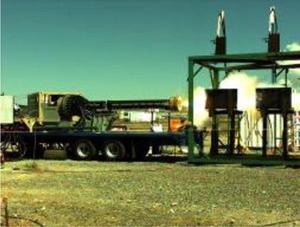Rail gunGeneral Atomic says its Blitzer rail gun already "tactically relevant"
Last Friday the U.S. Navy tested a rail gun with muzzle energies of 64 megajoules; the gun aims to deliver a projectile to a target 200 miles away at speeds of up to Mach 7+; not to be outdone, General Atomics has just released information about how, back in September, it tested its own rail gun — dubbed the Blitzer; while the Navy researchers are still preoccupied with the velocity of the projectile and muzzle energy, GA says it is farther along in weaponizing its system, which it describes as already “tactically relevant”

Blitzer during operational testing // Source: deagel.com
Rail guns are the rage. Following Friday’s 33-megajoule test shot carried out at a U.S. Navy laboratory (“U.S. Navy demonstrates 100-mile hypersonic rail gun test shot,” 14 December 2010 HSNW), it has also been announced that a different rail gun known as “Blitzer” has recently carried out firings which suggest that it is almost combat ready.
The Blitzer was developed by General Atomics, a company which made its name developing UAVs and electromagnetic mass-driver catapults for aircraft carriers, among other things. Now, in a statement which is dated 7 December, but which did not appear on the firm’s Web site until a week later), General Atomics says that the Blitzer was carrying out “tactically relevant” shoots back in September, three months before the Naval Surface Warfare Center Dahlgren test on 10 December.
Lewis Page writes that the Dahlgren rail gun shot was a step toward projectiles launched at Mach 7+ with muzzle energies of 64 megajoules, which would, when weaponized, be able to fly 200 miles and hit their targets still going at Mach 5. Such long-range over the horizon bombardment is one of the stated aspirations of the U.S. Navy’s rail gun project. The test guns at Dahlgren, however, are not weapons and their projectiles are not yet designed to fly through the air for any distance — they are focused on movement along the launching rails, from which they emerge at Mach 7.5.
Page writes that Blitzer, on the other hand, is less about ultimate velocity and muzzle energy and more about proving a viable weapon. Its projectiles fly at only Mach 5, but they are much more advanced toward being actual munitions. In the Blitzer, the armature which moves along the rails and carries the driving current between them is merely a “sabot” which propels the actual projectile to launch speed and then falls off shortly after clearing the muzzle —rather as in the case of modern armor piercing tank ammunition, which consists of a fin-stabilized penetrator dart which rides down the cannon barrel on discarding sabots.
According to the new GA statement:
This test demonstrated the integration and capabilities of a tactically relevant EM railgun launcher, pulsed power system, and projectile… The projectiles were launched by the Blitzer system at Mach 5 speed with acceleration levels exceeding 60,000 gee, and exhibited repeatable sabot separation and stable flight.
Blitzer will provide leap-ahead multi-mission capability in both naval and land-based
